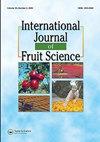西班牙瓦伦西亚社区葡萄遗传资源特征分析
IF 2.4
3区 农林科学
Q2 HORTICULTURE
引用次数: 4
摘要
葡萄种植在地中海盆地周围具有重要的历史意义。西班牙黎凡特是一个葡萄品种丰富的地区,在那里仍然可以找到用于生产葡萄酒、鲜食葡萄和葡萄干的古老品种。然而,对于其中一些被忽视的品种,从来没有做过完整的描述;因此,现行立法不允许将其用于商业用途。古老品种的植物学特征是鉴定它们的重要一步,也可以帮助澄清同义和同义,这是该作物经常遇到的问题。目前的工作提供了七个基因型的ampelography描述,其中微卫星标记谱已经可用,并讨论了他们的名字可能的起源,以及同义词和同义的实例。根据官方方法,对来自西班牙黎凡特的7份古葡萄基因型进行了原位葡萄腔分析。记录了它们的叶子、束和浆果的特征。在本工作中所做的ampelography描述提供了对所检查基因型的培养历史的深入了解,并将为将其列入西班牙国家目录铺平道路,这将允许其商业使用。收集到的这些基因型名称的可能来源信息,以及同义和同义的实例,丰富了我们对这一回收种质的认识。目前的结果有助于我们对欧洲葡萄藤遗传多样性的理解,并强调了保护它的必要性。本文章由计算机程序翻译,如有差异,请以英文原文为准。
Characterization of Grapevine Genetic Resources in the Comunitat Valenciana (Spain)
ABSTRACT Grapevine cultivation is of historic importance arround the Mediterranean basin. The Spanish Levant is an area of notable grapevine diversity, where ancient varieties destined for producing wine, table grapes and raisins can still be found. For some of these neglected varieties, however, no complete description has ever been made; current legislation does not, therefore, allow their commercial use. The botanical characterization of old varieties is an important step toward their identification and can also help to clarify synonymies and homonymies, problems very commonly encountered with this crop. The present work provides ampelographic descriptions of seven genotypes for which microsatellite marker profiles were already available, and discusses the possible origins of their names, as well as instances of synonymy and homonymy. Seven accessions of ancient grapevine genotypes from the Spanish Levant were subjected to in situ ampelographic analysis following official methods. The characteristics of their leaves, bunches and berries were recorded. The ampelographic descriptions made in the present work provide insight into the history of cultivation of the examined genotypes and would pave the way for their inclusion in the Spanish national catalog, which would allow their commercial use. The information gathered on the possible origin of these genotypes’ names, and instances of synonymy and homonymy, enriches our knowledge of this recovered germplasm. The present results contribute toward our understanding of Europe’s grapevine genetic diversity, and highlight the need to conserve it.
求助全文
通过发布文献求助,成功后即可免费获取论文全文。
去求助
来源期刊

International Journal of Fruit Science
Agricultural and Biological Sciences-Agronomy and Crop Science
CiteScore
6.40
自引率
0.00%
发文量
64
审稿时长
10 weeks
期刊介绍:
The International Journal of Fruit Science disseminates results of current research that are immediately applicable to the grower, extension agent, and educator in a useful, legitimate, and scientific format. The focus of the journal is on new technologies and innovative approaches to the management and marketing of all types of fruits. It provides practical and fundamental information necessary for the superior growth and quality of fruit crops.
This journal examines fruit growing from a wide range of aspects, including:
-genetics and breeding
-pruning and training
-entomology, plant pathology, and weed science
-physiology and cultural practices
-marketing and economics
-fruit production, harvesting, and postharvest
 求助内容:
求助内容: 应助结果提醒方式:
应助结果提醒方式:


